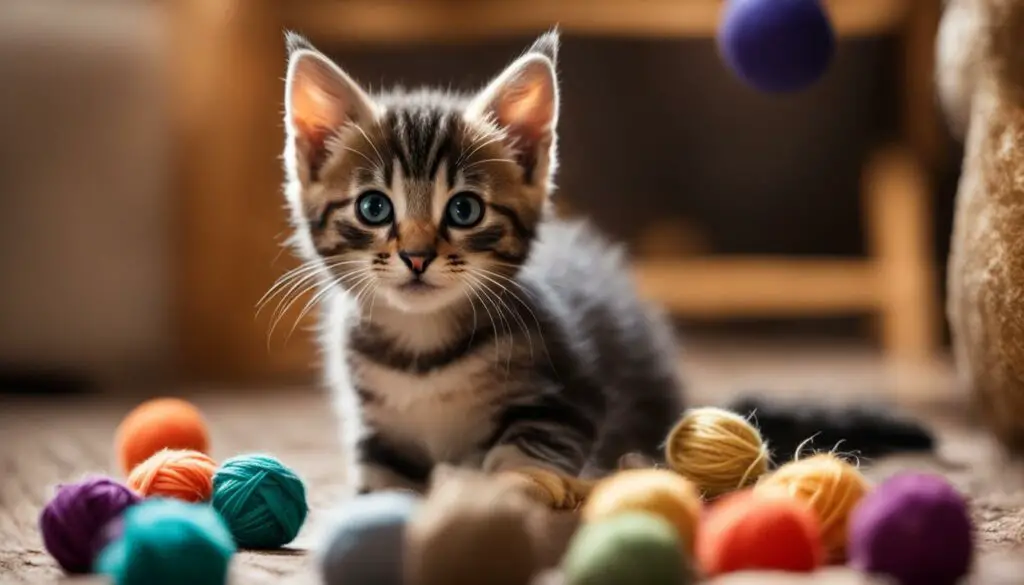Greetings fellow cat lovers! Today, I will delve into the fascinating world of kittens and their playtime habits. Have you ever wondered how long kittens can play before they need a break? Well, you’re about to find out!
Kittens are known for their playful nature and boundless energy. But just like us, they also have their limits. Understanding how long kittens can play before they get tired can help ensure their well-being and happiness. Let’s explore the factors that influence their playtime and how we can provide them with the right balance of play and rest.
Key Takeaways:
- Playtime duration in kittens varies based on factors such as age and personality.
- Younger kittens engage in shorter bursts of playtime than older kittens.
- Observing your kitten for signs of fatigue is essential. Provide rest when needed.
- Creating a stimulating environment with interactive toys can keep kittens entertained.
- Balancing playtime with rest is crucial for your kitten’s overall well-being.
Factors Affecting Playtime in Kittens
Kitten playtime duration can vary based on several factors that influence their energy levels and engagement. Understanding these factors can help you create an enriching play environment for your furry friend.
- Age: Younger kittens generally have shorter attention spans and tire more easily compared to older kittens. As they grow, their play sessions can extend to around 30 minutes or more.
- Breed: Different breeds may have varying playtime needs. Some breeds, such as the Bengal or Abyssinian, are known to be more active and require longer play sessions.
- Personality: Each kitten has a unique personality that can influence their playtime duration. Some kittens may be more energetic and require longer play sessions, while others may prefer shorter bursts of play.
By taking these factors into consideration, you can better tailor your playtime routine to meet your kitten’s individual needs.
Table 2: Factors Affecting Playtime in Kittens
| Factors | Effect on Playtime Duration |
|---|---|
| Age | Younger kittens have shorter attention spans and tire more easily. As they grow, play sessions can extend to around 30 minutes or more. |
| Breed | Different breeds may have varying playtime needs, with some requiring longer play sessions. |
| Personality | Each kitten has a unique personality that can influence their playtime duration. Some kittens may prefer shorter bursts of play, while others may require longer play sessions. |
Observing your kitten’s behavior and adapting their playtime accordingly is key in providing them with a fulfilling play experience. Remember to create a stimulating environment with interactive toys to keep them engaged and monitor their energy levels to ensure a healthy balance between play and rest.
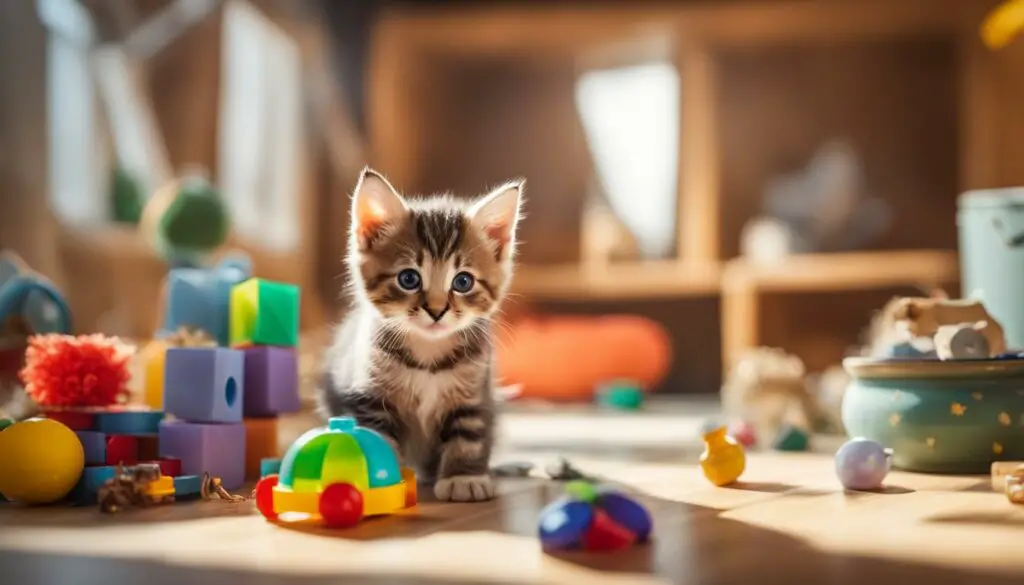
Types of Play in Kittens
Kittens engage in two main types of play: predatory play and social play. Predatory play involves activities like chasing, pouncing, and swatting at toys or objects. This type of play mimics the hunting behavior of their wild ancestors and helps kittens develop their coordination, agility, and hunting skills. It also provides them with mental stimulation and helps burn off excess energy.
“Kittens engage in two main types of play: predatory play and social play.”
Social play, on the other hand, involves interactions with other kittens or humans. It includes activities such as wrestling, play fighting, and chasing each other’s tails. Social play helps kittens develop their social skills, learn boundaries, and build bonds with their littermates or human companions. It also promotes exercise and can be a source of entertainment for both the kittens and the humans involved.
“Social play helps kittens develop their social skills, learn boundaries, and build bonds with their littermates or human companions.”
Both types of play are important for kittens’ physical and social development. Engaging in these play behaviors allows kittens to explore their surroundings, develop their physical abilities, and learn important life skills. It’s essential for kitten owners to provide opportunities for both predatory and social play to ensure their kittens’ well-being and optimal development.
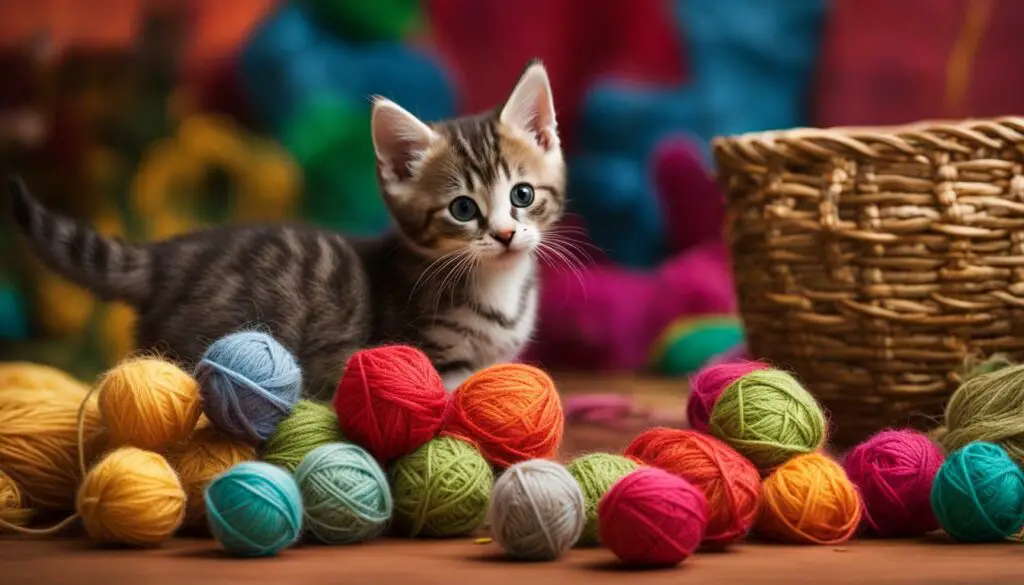
| Type of Play | Description |
|---|---|
| Predatory Play | Involves activities like chasing, pouncing, and swatting at toys or objects. Mimics hunting behavior and helps develop coordination, agility, and hunting skills. |
| Social Play | Involves interactions with other kittens or humans, such as wrestling, play fighting, and chasing each other’s tails. Helps develop social skills, learn boundaries, and build bonds. |
Signs of Fatigue in Kittens
Kittens are naturally playful creatures, but they do have their limits. It’s important to recognize the signs that your kitten is tired and in need of a break. Here are some common signs that indicate your kitten is getting fatigued:
- Reduced activity: Your kitten may start to slow down and become less active during playtime.
- Panting or heavy breathing: When kittens get tired, they may start to breathe more rapidly or pant.
- Excessive grooming: Some kittens may start grooming themselves excessively when they are tired.
- Seeking quiet spaces: Your kitten may start looking for quiet and secluded areas to rest.
- Disinterest in play: When your kitten is tired, they may lose interest in playing and become less engaged.
When you notice these signs, it’s important to give your kitten a break and provide them with a quiet and comfortable space to rest. Pushing your kitten to continue playing when they are tired can lead to overexertion and potential health issues.

Kitten Energy Levels and Playtime Needs
When it comes to kittens, understanding their energy levels and playtime needs is crucial for their overall well-being. Just like human children, kittens have different levels of energy and varying playtime requirements. Providing a stimulating environment is essential to keep them entertained and engaged. Let’s explore how you can ensure your kitten gets the right amount of play and mental stimulation.
Factors Influencing Kitten Energy Levels
Several factors can affect a kitten’s energy levels. Age, breed, and individual personality all play a role in determining how active a kitten is. For example, younger kittens tend to have higher energy levels compared to older ones. Certain breeds, such as Bengal or Abyssinian cats, are known to be more energetic than others. However, even within the same breed, each kitten can have a unique energy level. Observing your kitten’s behavior will give you a good idea of how much playtime they need.
| Factors | Energy Level |
|---|---|
| Age | High for younger kittens, moderate for older kittens |
| Breed | Varies, some breeds are more energetic |
| Personality | Varies, each kitten is unique |
Playtime Needs for Kittens
It’s important to meet the playtime needs of your kitten to prevent behavioral issues and promote their physical and mental development. Regular play sessions help kittens burn off excess energy, improve their coordination, and provide mental stimulation. The duration and frequency of playtime depend on your kitten’s age and energy level. Younger kittens may need multiple short play sessions throughout the day, while older kittens can have longer play sessions.
“Regular play sessions help kittens burn off excess energy, improve their coordination, and provide mental stimulation.”
Creating a Stimulating Environment
A stimulating environment is essential to keep your kitten engaged and active. Providing a variety of interactive toys, such as feather wands, puzzle toys, or balls, can help keep them entertained. It’s important to rotate the toys regularly to prevent boredom. Additionally, setting up vertical spaces, such as climbing trees or shelves, can provide opportunities for your kitten to explore and exercise their natural instinct to climb. Creating a stimulating environment will help ensure your kitten has a fulfilling playtime experience.

Duration of Playtime for Kittens
When it comes to playtime for kittens, there is no one-size-fits-all answer to how long they should play each day. The duration of playtime can vary based on several factors, including the kitten’s age, breed, and personality. While some kittens may prefer shorter, more frequent play sessions, others may enjoy longer periods of active play. It’s important to observe your kitten’s behavior and adjust playtime accordingly to ensure they are adequately stimulated and not overexerted.
For younger kittens, several short play sessions throughout the day may be appropriate. These sessions can range from 5 to 10 minutes each, allowing your kitten to engage in bursts of playful energy without becoming overly fatigued. As kittens grow older, their playtime can naturally extend to around 30 minutes or more per session. However, it’s essential to monitor their energy levels and provide rest when they show signs of tiredness.
Remember that playtime should be a balance between exercise and rest. Kittens also need time to recharge and sleep, so it’s important not to overwhelm them with constant play. By providing regular play sessions with appropriate durations and allowing for rest in between, you can ensure that your kitten stays happy, healthy, and well-adjusted.
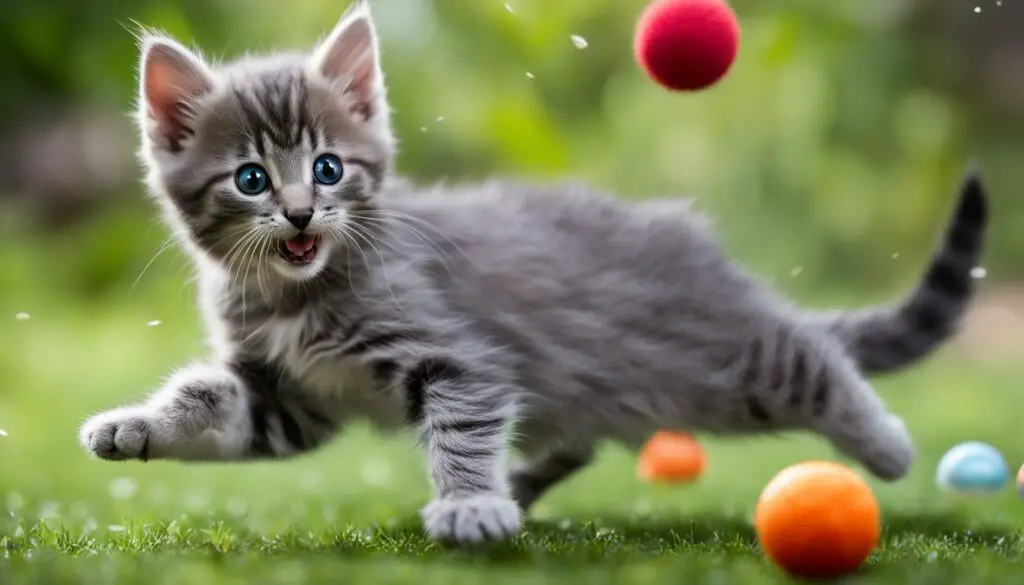
Recommended Play Sessions for Kittens
While specific playtime recommendations may vary, a general guideline for older kittens is to aim for at least two to three play sessions per day, lasting around 15 to 30 minutes each. These sessions can be scheduled at different times throughout the day, allowing your kitten to engage in active play and burning off excess energy.
| Kitten Age | Recommended Playtime Duration |
|---|---|
| 8-12 weeks | 5-10 minutes per session, several times a day |
| 12-16 weeks | 10-15 minutes per session, several times a day |
| 16-24 weeks | 15-20 minutes per session, two to three times a day |
| 6 months and older | 20-30 minutes per session, two to three times a day |
These durations can serve as a starting point, but it’s important to remember that every kitten is unique. Some kittens may have higher energy levels and need more playtime, while others may require less. The key is to provide regular opportunities for play and observe your kitten’s behavior to ensure that their playtime needs are met.
How to Engage Kittens in Playtime
Engaging kittens in playtime is an essential part of their development and well-being. Interactive play allows them to exercise their natural instincts, burn off energy, and build important skills. Here are some tips to help you create an interactive and enjoyable playtime experience for your kitten:
- Choose engaging toys: Provide a variety of toys that stimulate your kitten’s senses and encourage active play. Toys with feathers, bells, or small balls can be especially enticing. Avoid toys with small parts that can be swallowed.
- Rotate toys regularly: Kittens can quickly lose interest in the same toys, so rotate them regularly to keep things fresh and exciting. Introduce new toys and put away others for a few days to maintain their novelty.
- Play chase games: Use a feather wand or a toy that mimics prey to engage your kitten in chase games. Move the toy in a way that imitates the movement of a bird or a mouse, stimulating their natural hunting instincts.
- Provide climbing opportunities: Kittens love to climb and explore their surroundings. Set up vertical spaces, such as cat trees or shelves, where they can climb and jump safely. This not only keeps them active but also provides mental stimulation.
Remember to always supervise playtime and ensure the environment is safe and kitten-proofed. Avoid using your hands or feet as play toys to prevent them from associating human body parts with play aggression. Playing with your kitten regularly helps strengthen the bond between you and provides important socialization opportunities. Enjoy the playtime together and create a positive and engaging experience for your furry friend!
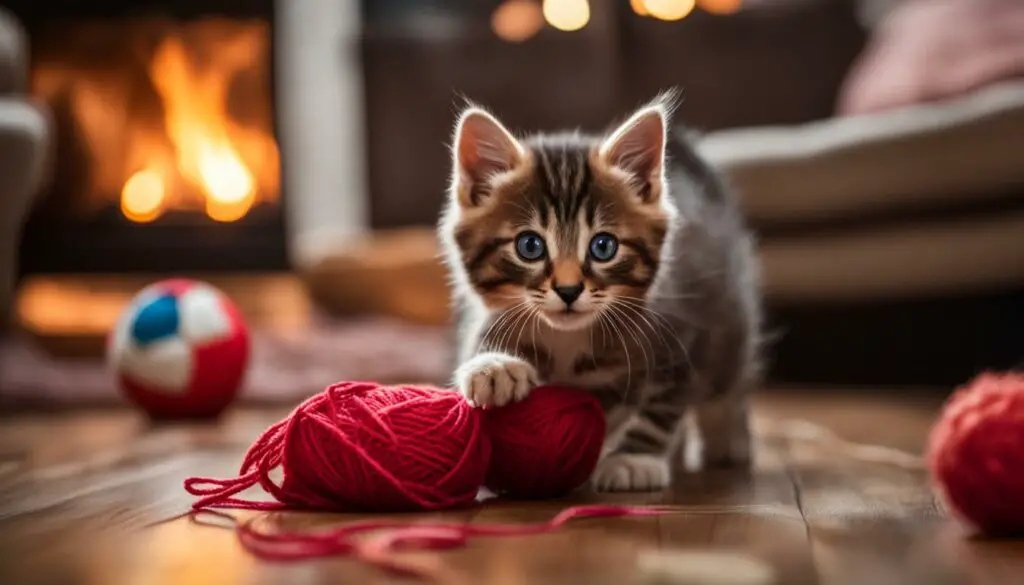
Testimonials from Happy Kitten Owners
“My kitten absolutely loves interactive toys! The feather wand is her favorite, and we have so much fun playing chase together. It’s a great way to bond and keep her entertained.”
“Rotating toys has made such a difference in my kitten’s playtime. She gets excited when I bring out a toy she hasn’t seen in a while, and it keeps her engaged for longer play sessions.”
“Creating climbing opportunities has been a game-changer for my kitten. She loves exploring the vertical spaces, and it’s impressive to see her agility. Plus, it gives her a break from her usual play routine.”
By incorporating these tips into your kitten’s playtime routine, you can provide an interactive and stimulating environment that promotes their physical and mental well-being. Remember to have fun and enjoy the precious moments of play with your playful feline companion!
Balancing Playtime and Rest
When it comes to playtime for kittens, finding the right balance between activity and rest is crucial for their overall well-being. While play is important for their development, kittens also need plenty of rest to support their growth and prevent over-tiredness or overstimulation.
Observing your kitten’s behavior is key to understanding their playtime needs. Signs of fatigue can include reduced activity, panting or heavy breathing, excessive grooming, seeking quiet spaces, and disinterest in play. When you notice these signs, it’s important to provide your kitten with a break and a chance to rest.
A good approach to balancing play and rest is to provide several short play sessions throughout the day. As your kitten grows older and develops more stamina, you can gradually increase the duration and frequency of playtime sessions. This allows them to burn off energy while still getting enough rest to recharge.
| Benefits of Balancing Playtime and Rest |
|---|
| Prevents overstimulation: Too much play without adequate rest can lead to overstimulation and exhaustion in kittens. Balancing play and rest allows them to avoid becoming overwhelmed and promotes a healthy level of activity. |
| Supports growth and development: Kittens need plenty of rest to support their growing bodies and minds. Just like human babies, they require a balance between stimulation and downtime to ensure proper development. |
| Reduces stress: Playtime is meant to be fun and enjoyable for kittens. By balancing play with rest, you can help reduce their stress levels and create a positive environment for them to thrive in. |
Remember, every kitten is unique, so it’s important to pay attention to their individual needs. By striking the right balance between playtime and rest, you can ensure that your kitten stays healthy, happy, and full of energy.
Playtime Tips for Kittens
When it comes to playtime with kittens, it’s important to provide them with engaging activities that keep them entertained and prevent overstimulation. Here are some useful tips to make the most out of your kitten’s playtime:
- Use interactive toys: Interactive toys, such as feather wands or moving toys, are excellent choices to keep your kitten engaged during playtime. These toys mimic natural prey movements, stimulating your kitten’s predatory instincts and providing a fun and engaging experience.
- Play chase: Engage your kitten in a game of chase by using a toy or by simply running around. This activity helps them burn off excess energy and encourages running and jumping, which are essential for their physical development.
- Rotate toys regularly: Kittens can get bored easily, so it’s important to rotate their toys regularly to keep them interested. Introduce new toys and put away the ones they have been playing with to create novelty and excitement during playtime.
- Set up playdates: Socialization is crucial for kittens, so consider setting up playdates with other kittens or cats. This allows them to engage in social play and learn appropriate social behaviors.
Remember to pay close attention to your kitten’s behavior during playtime. If they show signs of tiredness or overstimulation, such as excessive panting or disinterest in play, it’s important to give them a break and provide a quiet and comfortable space for rest.
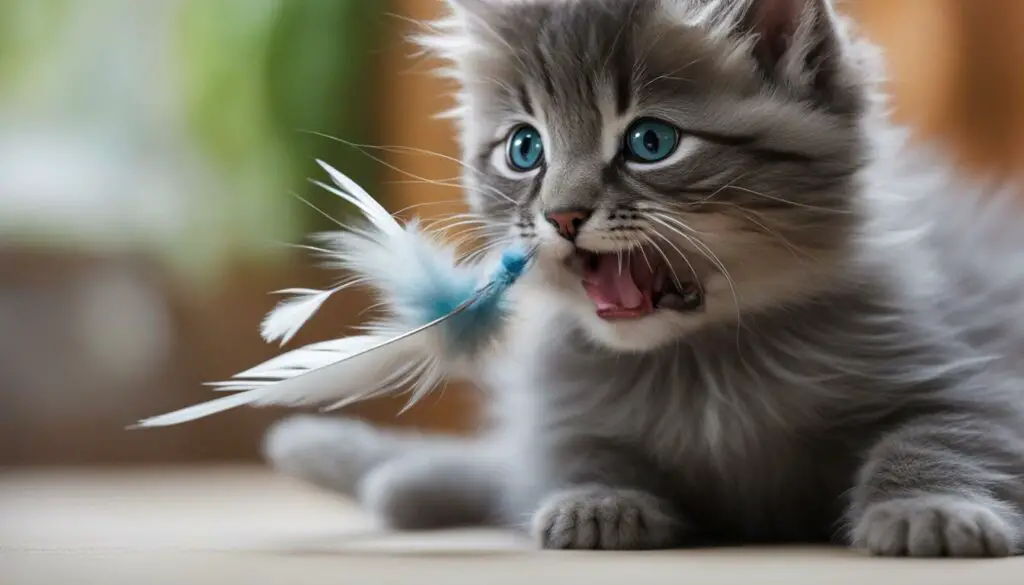
Playtime is a wonderful opportunity for bonding with your kitten and promoting their physical and mental development. By following these tips, you can ensure that playtime remains an enjoyable and stimulating experience for both you and your furry friend.
The Importance of Play for Kittens
Playtime is an essential part of a kitten’s development, offering numerous benefits for their physical and mental well-being. Through play, kittens have the opportunity to develop their motor skills, coordination, and agility. Whether it’s chasing after a toy or engaging in social play with other kittens or humans, play helps kittens refine their movements and enhance their overall physical abilities.
Additionally, playtime is crucial for the social development of kittens. It allows them to practice their social skills, such as communication and boundaries, through activities like wrestling and play fighting. Engaging in social play teaches kittens how to interact with others in a playful and non-threatening manner, which is invaluable for their future interactions with fellow feline companions and their human families.
“Playtime offers a safe and constructive outlet for kittens to burn off excess energy and reduce stress.”
Furthermore, playtime offers a safe and constructive outlet for kittens to burn off excess energy and reduce stress. Just like human children, kittens have boundless energy, and play provides them with an opportunity to channel that energy in a positive way. Regular play sessions can help prevent behavioral issues that may arise from pent-up energy, such as excessive scratching or destructive behavior.
In conclusion, playtime is not just a source of entertainment for kittens; it is an essential component of their development. From improving their physical abilities and social skills to providing an outlet for energy, playtime plays a vital role in shaping kittens into healthy, happy, and well-adjusted feline companions.
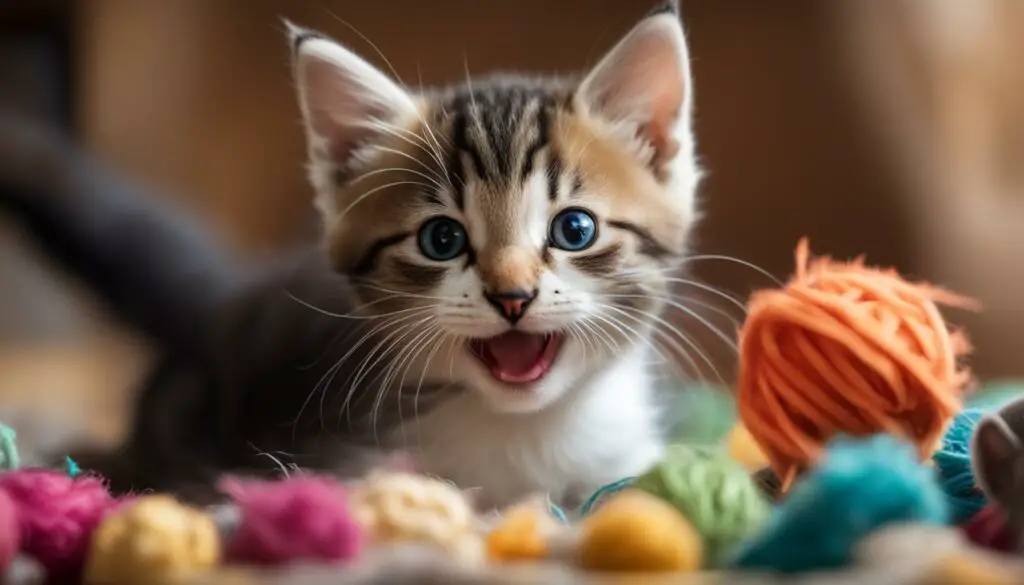
Balancing Playtime and Sleep
When it comes to kittens, finding the right balance between playtime and sleep is essential. Just like human babies, kittens need plenty of rest to support their growth and development. However, they also have a boundless amount of energy that requires an outlet. So, how can we strike a balance between their playtime needs and the need for adequate sleep?
First and foremost, it’s important to create a schedule that includes regular play sessions throughout the day. Kittens have short attention spans, so several short play sessions are more beneficial than one long session. This allows them to burn off their excess energy while preventing overstimulation and exhaustion. By providing structured playtime, you can ensure that your kitten gets the exercise they need without compromising their sleep.
Additionally, creating a comfortable and safe sleeping area for your kitten is crucial. Kittens need a quiet and cozy space where they can retreat to when they’re ready to sleep. Consider providing a warm bed or blanket and ensure that the area is free from noise and distractions. This will help your kitten relax and get the rest they need after an active play session.
| Playtime Needs | Sleep Needs |
|---|---|
| Regular interactive play sessions | Quiet and cozy sleeping area |
| Short bursts of play throughout the day | Adequate amount of uninterrupted sleep |
| Engaging toys and activities | Safe and comfortable sleep environment |
Remember, it’s important to pay attention to your kitten’s behavior and adjust playtime and sleep accordingly. If your kitten shows signs of fatigue, such as reduced activity or disinterest in play, it’s time to give them a break and allow them to rest. On the other hand, if your kitten is full of energy and playfulness, engaging them in interactive play can help channel their energy in a positive way. Finding the right balance might take some trial and error, but with observation and intuition, you’ll be able to create a routine that suits your kitten’s individual needs.
By finding the right balance between playtime and sleep, you can ensure that your kitten stays healthy, happy, and well-rested. So, set aside time for play, provide a comfortable sleep environment, and pay attention to your kitten’s cues. With a little effort and understanding, you can create a harmonious routine that promotes both playfulness and relaxation in your furry friend.
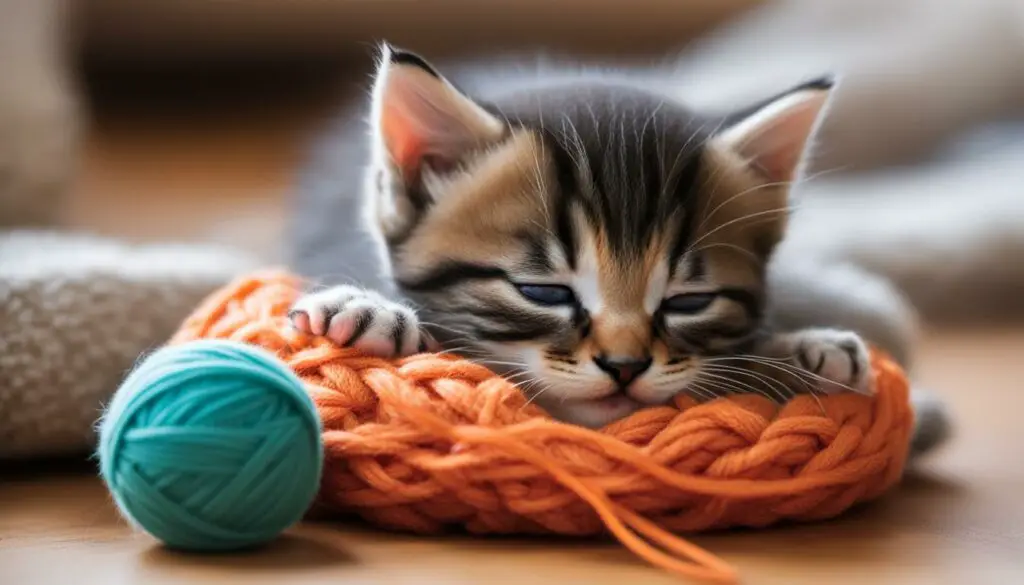
Tips for Calming a Hyperactive Kitten
If you have a hyperactive kitten that constantly bites and scratches, don’t worry, there are several tips you can try to help calm them down. It’s important to remember that kittens have a lot of energy, and it’s natural for them to exhibit playful behavior. However, if their hyperactivity becomes excessive or destructive, these tips can help redirect their energy and promote a calmer demeanor.
Providing Interactive Toys
Interactive toys can be a great tool for redirecting a hyperactive kitten’s energy. Toys that encourage chasing, batting, and pouncing can help them release their excess energy in a positive and stimulating way. Choose toys that mimic prey, such as feather wands or interactive treat puzzles, to engage their natural hunting instincts. Providing a variety of toys and rotating them regularly can also help keep their interest and prevent boredom.
Redirecting Biting and Scratching
If your hyperactive kitten tends to bite or scratch, it’s important to redirect their behavior onto appropriate objects. When they start to bite or scratch, immediately replace your hand or other body parts with a toy. This will teach them that biting and scratching toys is acceptable while discouraging them from engaging in these behaviors with you. You can also use positive reinforcement by rewarding them with treats or praise when they play gently and interact with toys instead of biting or scratching.
Creating a Stimulating Environment
A hyperactive kitten may benefit from a stimulating environment that provides plenty of opportunities for play and exploration. Set up a designated play area with climbing structures, scratching posts, and interactive toys. This will not only keep them physically and mentally engaged but also help redirect their energy away from destructive behaviors. Additionally, consider providing vertical spaces for climbing and jumping, such as cat trees or shelves, to encourage them to burn off excess energy and engage in natural feline behaviors.
By implementing these tips and techniques, you can help calm your hyperactive kitten and redirect their energy towards positive and engaging activities. Remember to be patient and consistent in your approach, as it may take some time for your kitten to adjust their behavior. If your kitten’s hyperactivity persists or becomes a cause for concern, consulting with a veterinarian or animal behaviorist can provide additional guidance and support.

Conclusion
Understanding the playtime needs of kittens is essential for their overall development and well-being. While the duration of playtime can vary based on individual factors, there are some helpful tips to follow. First and foremost, provide interactive play sessions with engaging toys to keep your kitten entertained and mentally stimulated.
It’s important to monitor your kitten’s behavior and recognize signs of fatigue, such as reduced activity or disinterest in play. When you notice these signs, be sure to provide your kitten with ample rest and relaxation. Balancing playtime with rest is crucial to prevent overstimulation and exhaustion.
Remember, playtime not only helps kittens develop important skills like coordination and socialization, but it also allows them to burn off excess energy and reduce stress. By creating a stimulating environment, offering a variety of toys, and setting up playdates for socialization, you can provide your kitten with a well-rounded play experience.
Finally, consult with a veterinarian or animal behaviorist if you have a hyperactive kitten that exhibits excessive biting and scratching behaviors. They can provide valuable advice on redirecting and calming these behaviors.
FAQ
How long do kittens play before they get tired?
The duration of playtime in kittens can vary based on factors like age and personality. Younger kittens may engage in short bursts of play, while older kittens can play for longer periods.
What factors affect playtime in kittens?
Playtime duration in kittens can be influenced by factors such as age, breed, and individual personality.
What are the types of play in kittens?
Kittens engage in two main types of play: predatory play, which involves chasing and pouncing at toys, and social play, which includes activities like wrestling and play fighting.
What are the signs of fatigue in kittens?
Signs that a kitten is tired after playtime can include reduced activity, panting or heavy breathing, excessive grooming, seeking quiet spaces, and disinterest in play.
What are the playtime needs of kittens?
Kittens have different energy levels and playtime needs. It’s important to provide a stimulating environment with interactive toys and adjust playtime based on their behavior.
How long should kittens play each day?
There is no specific number of hours that kittens should play each day. Playtime duration varies based on factors like age, breed, and personality. Younger kittens may need several short play sessions, while older kittens can have longer play sessions.
How can I engage kittens in playtime?
You can engage kittens in playtime by using interactive toys, playing chase, and providing vertical space for climbing and jumping. Rotating toys and setting up playdates with other kittens or cats can also be effective.
How do I balance playtime and rest for kittens?
It’s important to balance playtime and rest for kittens. Provide regular play sessions while also allowing for plenty of rest and sleep to support their growth and prevent over-tiredness or overstimulation.
What are some tips for kitten playtime?
Use interactive toys, keep kittens engaged with stimulating activities, and provide several short play sessions throughout the day. Gradually increase the duration and frequency of play as your kitten grows older and develops stamina.
Why is play important for kittens?
Playtime is crucial for kittens’ physical and mental development. It helps them develop motor skills, coordination, agility, and social skills. Playtime also allows kittens to burn off excess energy and reduce stress.
How do I balance playtime and sleep for kittens?
Balance playtime and sleep for kittens by providing regular play sessions and a comfortable, safe sleeping area. Too much play without adequate rest can lead to overstimulation and exhaustion.
What are some tips for calming a hyperactive kitten?
Ensure your kitten has enough playtime and mental stimulation, offer interactive toys to redirect biting and scratching behavior, and provide a stimulating environment. Consulting with a veterinarian or animal behaviorist may also be helpful.
Conclusion
The duration of playtime in kittens varies based on factors like age and personality. It’s important to provide interactive play, monitor their behavior for signs of fatigue, and balance playtime with rest. Playtime is essential for kittens’ development and well-being, helping them develop various skills.

